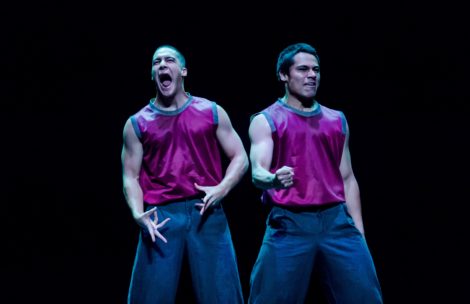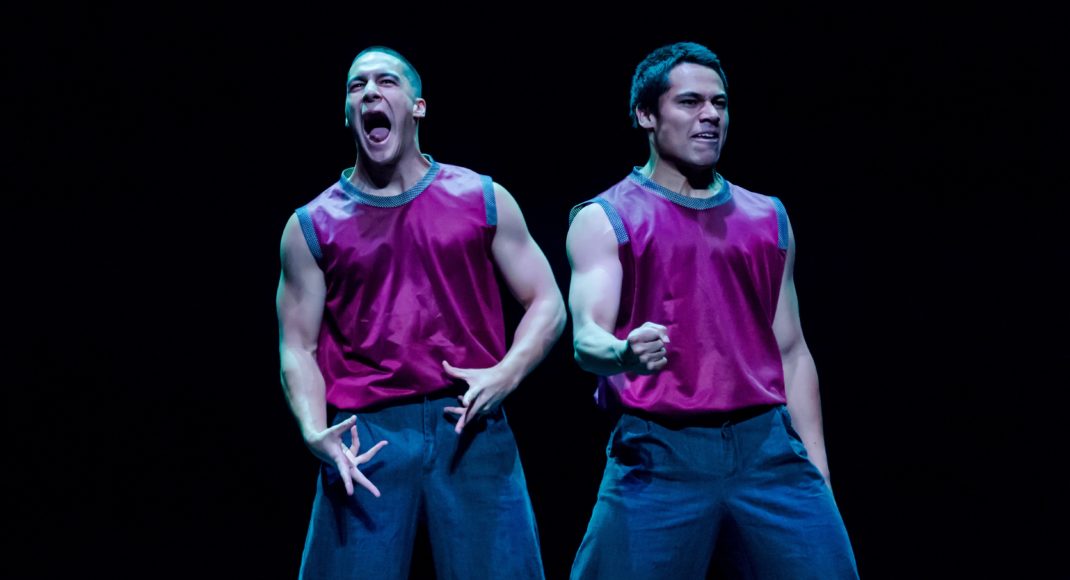The appointment of Patricia Barker as artistic director of Royal New Zealand Ballet has not been without controversy! Jennifer Shennan’s review of the 2017 50th anniversary show from New Zealand School of Dance with Royal New Zealand Ballet, in which she mentioned that no graduates from the School had been accepted into the New Zealand company, sparked a number of very thoughtful comments on this website. Scroll down through this link to read those comments. Discussions offline have been continuing with gusto.
This morning the following article appeared in New Zealand’s Sunday Star Times suggesting that things are moving to a whole new level.

Michelle Potter, 24 December 2017
Featured image: Toa Paranihi and Connor Masseurs in S.U.B. New Zealand School of Dance, 2017. Photo: © Stephen A’Court


From the information recently released by RNZB it would seem that at the start of 2018 just 7 of the 36 dancers are New Zealanders, i.e. about 20%. Of these 5 had attended the NZ School of Dance. A further 5 dancers (3 Australian & 2 Brazilian) in the company had also attended the NZSD.
As the Royal New Zealand Ballet company it seems to me that policies should be put in place to ensure that in future many more NZ dancers are recruited, to bring the total up to somewhere near 50% of the company, to justify the continued use of the title.
Yes, I am watching the situation with much interest. Your point about the use of the name of the company is interesting!
I really did not want to get involved with this situation; I was too far away from the events and did not have the background details needed to voice an opinion. I did however find it all terribly depressing. It made me ashamed that for the third time the same people with their same arrogance and complete lack of understanding of the delicate artistic structure that holds a ballet company together, were at work again. With dancers being scattered in all directions the very soul of our truly New Zealand Ballet is under attack once again and by the same enemy.
It’s really not difficult to predict the direction any given candidate for the position of Artistic Director of a ballet company will take if elected. The three questions that should be asked in the first round are:
Where do they come from? Where did they train? Where did they dance?
In Patricia Barker’s case all the answers can be found in 10 min. on Utube. She had her early training in a provincial American town, danced with Pacific North West Ballet for 27 years. A good company with a strong American identity and heavy exposure to the Balanchine repertoire. At this stage the alarm bells should have started ringing.
Without going into analytic details it seems clear that she will be imposing ideas and concepts developed in America for Americans on an arts organisation that has grown and developed its cultural identity in New Zealand. From past mistakes we know this can’t work.
The reason why I am stepping up now and presenting my ideas is a rather unusual one. A week or so ago I had a Russian American family as guests staying at my small hotel here in provincial France. We were sitting around the fire place after dinner one evening, they were telling their story when to my amazement they started talking about Grand Rapids their hometown. From some of the posters on the walls they knew I was a dance person. At this point I started asking questions and yes indeed the same unpopular directorial techniques seem to have been used on the dancers of The Grand Rapids Ballet Company leading to mass firing and walkouts… Interesting.
In my 7 years with the Grand Rapids Ballet under Patricia Barker’s direction I have never experienced a mass firing or walk-out, so I’m not sure what “Gray Veredon” is talking about. Additionally, in her time here she has both expanded the company and improved the repertoire. Are those the “unpopular directorial techniques” to which you refer? This just sounds like someone with an axe to grind.
i had real concerns when I heard that Patricia had only an American background when she was appointed as I felt she would not understand the NZ psyche. For the dancers to give of their best they have to be really in tune with their director and be able to work together with a bond between them. With so many new overseas dancers this will be difficult.
Actually, Gray Veredon has had a distinguished career as a dancer, choreographer and artistic director working across the world including in New Zealand, Australia, France, Germany and the United States. I would be very surprised if he has an axe to grind.
But thank you SCH for your comments. We are all entitled to have an opinion.
The Royal New Zealand ballet appears to be no more immune to globalisation than the Royal Ballet or for that matter any other industry or non arts corporation. At one stage the principal line up of the Royal Ballet consisted of only two English dancers, Darcy Bussell and Jonathan Cope.
This is a tough, divisive and pretty complex issue in my opinion and it’s not exclusive to this company or this appointment. Is this more about the fact that the company isn’t made up of a majority of New Zealand nationals or dancers trained at the national school? – or is this more about the fact that the last two artistic directors weren’t Kiwis and appear to have used the company as I stepping stone without the heart felt care that would have been given by a director who had the national identity and love of New Zealand in their born DNA? Most likely it’s a combination of both?
There is a fair bit to consider here….The fact that non New Zealand dancers and directors of a very high calibre want to work in RNZB does say something about how far the company has come in the last 20 years in developing it’s international reputation and profile. Few companies so poorly funded have been able to build and maintain the standards and professionalism and this company has. Often against all odds. There’s no denying that the appointment of Ethan Stiefel brought the company into the view of a more international industry audience even if long term he wasn’t committed to the national cause.
Saying that Patricia Barkers appointment and her hire decisions are just wrong from the outset may be based on a fear of what appears to be the ‘use and drop’ tenures of the last two non NZ artistic directors and it might be a little short sighted. Perhaps understandably so.
I think it’s fair enough to question the board as to why its search for artistic directors have led to appointments from outside New Zealand but I think we need to be careful. There is nothing yet to say that Patricia Barker won’t bring excellence to the company and NZ audiences. It’s a tough one but I think that trying to make the company leadership and dancers purely or even mostly New Zealand is pretty much a thing of the past. In saying that though the board do need to consider whether the candidate does have an investment in the companies national cultural identity and aren’t just there for the ‘what’s in it for me?’ We don’t know that is the case with Patricia Barker.
Not easy!
Thank you for this considered analysis of the New Zealand situation.
Moderating comments on this and other related posts has made me think about situations that I know more about – those in Australia in particular. The artistic directors I have most admired have all had major careers of their own in more than one company and more than one country, along with exposure to a wide-ranging repertoire. This has given them, I think, an understanding of the peripatetic life that many dancers lead, or are forced to lead as a result of the paucity of employment opportunities. Some have put measures in place to combat the ups and downs that such a life may entail. They have also had (or still have if they are still alive) an absolute passion for the art form and a desire to motivate their dancers to reach their highest potential. What has resulted has been great repertoire and driven and energised dancers.
It is too early to tell how the New Zealand situation will develop but I hope it is not a ‘stepping stone’ or ‘use and drop’ situation (to borrow your phrases). No company deserves that and I understand the anxiety many feel. I hope too that the dancers are treated with the respect they deserve.